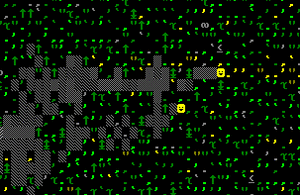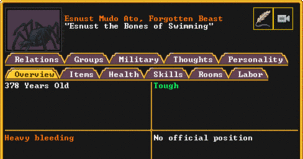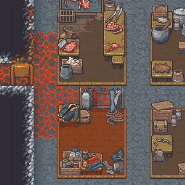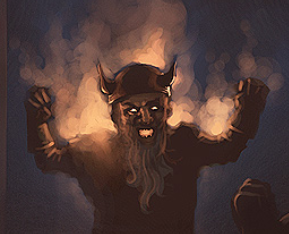- v50 information can now be added to pages in the main namespace. v0.47 information can still be found in the DF2014 namespace. See here for more details on the new versioning policy.
- Use this page to report any issues related to the migration.
Difference between revisions of "Fire"
(→Spread & Effect: actual temperature of burning grass) |
m |
||
| (14 intermediate revisions by 5 users not shown) | |||
| Line 1: | Line 1: | ||
| − | {{Quality|Exceptional | + | {{Quality|Exceptional}} |
{{av}} | {{av}} | ||
| − | [[File: | + | [[File:fire_sprite_anim.gif|right]]'''Fire''', like its real-life counterpart, is an immensely [[fun|destructive]] force. Fires can spread and burn dwarves and furniture, generating [[smoke]]. Fire spreads over flammable surfaces, items and creatures. Dwarves caught in the blaze might end up dying, and items will slowly get [[wear|damaged]] until they get destroyed. In-game, entities which are on fire flash red and yellow. In item lists, anything which is on fire will also be surrounded by double exclamation marks, similarly to ‼THIS‼. |
| − | |||
| − | '''Fire''', like its real-life counterpart, is an immensely [[fun|destructive]] force. Fires can spread and burn dwarves and furniture, generating [[smoke]]. Fire spreads over flammable surfaces, items and creatures. Dwarves caught in the blaze might end up dying, and items will slowly get [[wear|damaged]] until they get destroyed. In-game, entities which are on fire flash red and yellow. In item lists, anything which is on fire will also be surrounded by double exclamation marks, similarly to ‼THIS‼. | ||
== Cause == | == Cause == | ||
| − | + | [[File:megabeast_fire_v50_anim.gif|thumb|303px|right|A megabeast burning to death.]][[File:Running around on fire.gif|thumb|'''‼'''Dwarves'''‼''' on fire (flashing red/yellow), and trailing [[smoke]].]]A fire can stem from several sources, for example: | |
| − | A fire can stem from several sources, for example: | ||
*[[Dragon]]s breathe [[dragonfire]], which can set most organic things on fire and melt fire-safe stone, at anything hostile they see. The dragonfire spreads out in a conical shape and ignites anything it touches. It is not the same as regular fire. | *[[Dragon]]s breathe [[dragonfire]], which can set most organic things on fire and melt fire-safe stone, at anything hostile they see. The dragonfire spreads out in a conical shape and ignites anything it touches. It is not the same as regular fire. | ||
| − | *[[Fire imp]]s can throw fireballs, which may set things alight | + | *[[File:fireball_sprite_anim.gif|thumb|32px|right|Imp fireball.]][[Fire imp]]s can throw fireballs, which may set things alight, while [[magma crab]]s can spit globs of liquid [[basalt]], which may set the [[grass]] or [[cave moss]] alight, causing fires. |
| − | + | *[[Magma]] will burn anything flammable it touches - however, any item set alight by this method will likely just be doused in magma until it is completely destroyed. | |
| − | *[[Magma]] will burn anything flammable it touches | + | **[[Magma mist]] burns stuff just as well as magma. |
| − | *[[Magma mist]] burns stuff just as well as magma. | ||
*Some [[titan]]s, [[forgotten beast]]s, and [[demon]]s can breathe fire/throw fireballs, too. | *Some [[titan]]s, [[forgotten beast]]s, and [[demon]]s can breathe fire/throw fireballs, too. | ||
| − | *[[Fire man|Fire men]] and [[magma man|magma men]], as well as other procedurally-generated beasts composed of flame, have high fixed body temperatures, causing them to spread fires (and [[fun]]) in their path. | + | *[[Fire man|Fire men]] and [[magma man|magma men]], as well as other procedurally-generated beasts composed of flame (''including some instances of the above''), have high fixed body temperatures, causing them to spread fires (and [[fun]]) in their path. |
| − | Note that it is currently difficult to safely start (and then, control) a fire. Fire is most easily started by either [[magma]] or a fire-breathing attack. An area enclosed by [[water]], metal, stone or Z-level difference can be used to start a fire, which can be used as a way of increasing [[FPS]] by removing objects or as part of a complex trap, though this may lead to [[fun]] when something comes out burning which then sets the rest of the fort on fire | + | Note that it is currently difficult to safely start (and then, control) a fire. Fire is most easily started by either [[magma]] or a fire-breathing attack. An area enclosed by [[water]], metal, stone or Z-level difference can be used to start a fire, which can be used as a way of increasing [[FPS]] by removing objects, or as part of a complex trap, though this may lead to [[fun]] when something comes out burning which then sets the rest of the fort on fire. |
== Spread & Effect == | == Spread & Effect == | ||
| − | Fire will spread to adjacent tiles containing flammable materials, including [[grass]], [[shrub]]s, [[log]]s, [[clothes]], [[dwarves]] (and generally all creatures that are not composed of [[fire-safe]] materials), multi-tile trees, wooden [[furniture]], [[building]]s, and [[road]]s, [[lignite]] and [[bituminous coal]] rocks, and bars of [[charcoal]], or [[coke]]. Except for dragonfire, fire won't burn rock or metal. Constructions (wall, floor, etc.) will currently never burn, no matter what. | + | [[File:magma_spill_anim.gif|thumb|185px|right|Magma spilling in, setting workshops ablaze.]]Fire will spread to adjacent tiles containing flammable materials, including [[grass]], [[shrub]]s, [[log]]s, [[clothes]], [[dwarves]] (and generally all creatures that are not composed of [[fire-safe]] materials), multi-tile trees, wooden [[furniture]], [[building]]s, and [[road]]s, [[lignite]] and [[bituminous coal]] rocks, and bars of [[charcoal]], or [[coke]]. Except for dragonfire, fire won't burn rock or metal. Constructions (wall, floor, etc.) will currently never burn, no matter what. |
| − | Fire will not spread across z-levels by itself. Walls with trapped passages block the fire, too. Both shrubs and trees can catch fire, and burning branches can potentially spread fires uphill. When aboveground, spreading fire can cause trees to collapse, and if it spreads too much, this can cause spam as the game repeatedly announces "Something outside has collapsed!" and pauses. Note that these collapses can cause holes in the ceiling of your fortress if it is directly below | + | Fire will not spread across z-levels by itself. Walls with trapped passages block the fire, too. Both shrubs and trees can catch fire, and burning branches can potentially spread fires uphill. When aboveground, spreading fire can cause trees to collapse, and if it spreads too much, this can cause spam as the game repeatedly announces "Something outside has collapsed!" and pauses. Note that these collapses can cause holes in the ceiling of your fortress if it is directly below. Therefore, some forest fires are sadly best left controlled, or not started. |
Fires burning in the environment (e.g. burning [[grass]]) start at a temperature of {{ct|10508}} and quickly heat up to {{ct|10708}}, while burning items rapidly heat up to 200 degrees above their ignition point (but stay slightly below that, because the surrounding air cools them a bit). Items experience rapid [[wear]]-based damage while burning, and continue to degrade until entirely destroyed. [[Fire-safe]]ty for any material is defined as being stable at a [[temperature]] of {{ct|11000}}. | Fires burning in the environment (e.g. burning [[grass]]) start at a temperature of {{ct|10508}} and quickly heat up to {{ct|10708}}, while burning items rapidly heat up to 200 degrees above their ignition point (but stay slightly below that, because the surrounding air cools them a bit). Items experience rapid [[wear]]-based damage while burning, and continue to degrade until entirely destroyed. [[Fire-safe]]ty for any material is defined as being stable at a [[temperature]] of {{ct|11000}}. | ||
=== Artifacts === | === Artifacts === | ||
| − | + | [[Artifact|Artifacts]] constructed from a flammable base material can burn, but will not experience any [[wear]], potentially leaving them burning forever, including artifacts used as part of a building. If an artifact is not stored in a bin, water will extinguish it. Artifacts with a melting or boiling point can still be destroyed if the items exceed those temperatures (as a result of combustion, [[magma]], or [[dragonfire|other sources]]). | |
| − | [[Artifact|Artifacts]] constructed from a flammable base material can burn, but will not experience any [[wear]], potentially leaving them burning forever | ||
Interestingly, because [[books]] are considered artifacts, they too will burn indefinitely, but because their copies aren't, such copies ''will'' burn up. | Interestingly, because [[books]] are considered artifacts, they too will burn indefinitely, but because their copies aren't, such copies ''will'' burn up. | ||
=== Ghosts === | === Ghosts === | ||
| − | + | One thing to note is that dwarves that burn to death do not leave remains, and will produce [[ghost]]s even if buried in a coffin. Be sure to engrave a memorial to all dwarves that burn to ashes, unless, of course, you ''want'' a ghost infestation. | |
| − | One thing to note is that dwarves that burn to death do not leave remains, and will produce | ||
== Dragonfire == | == Dragonfire == | ||
| Line 41: | Line 35: | ||
== Dangers == | == Dangers == | ||
| − | + | In recent versions of ''Dwarf Fortress'', dwarves (semi-correctly) see fire as a danger to themselves and try to avoid becoming ‼Dwarves‼. However, burning dwarves will carry out typical dwarven activities, despite the fact that the <s>dwarf</s> fire-swathed fool of an Urist is burning to death, and will spread the fiery destruction to their peers. {{verify}} This may not only kill your dwarves, but more importantly, also incinerate a good many useful items. Dwarves will not path through smoke reliably, so if you see a bunch of job cancellations due to pathing issues, a fiery dwarf is probably running around (or other [[fun]] is afoot). Alternatively, sometimes the smoke on the burning dwarf's tile prevents them from pathing anywhere, forcing them to be stationary while they burn. And don't, for Armok's sake, let the flaming dwarves anywhere near the booze. Contrary to popular belief, it doesn't ''explode'' (and never did), but it ''will'' boil away into nothing, which is always [[fun#No_Booze|fun]]. | |
| − | In recent versions of ''Dwarf Fortress'', dwarves see fire as a danger to themselves and try to avoid becoming ‼Dwarves‼. However, burning dwarves will carry out typical dwarven activities, despite the fact the dwarf is burning to death, and will spread the fiery destruction to their peers. {{verify}} This may not only kill your dwarves, but more importantly, also incinerate a good many useful items. Dwarves will not path through smoke reliably, so if you see a bunch of job cancellations due to pathing issues, a fiery dwarf is probably running around (or other [[fun]] is afoot). Alternatively, sometimes the smoke on the burning dwarf's tile prevents them from pathing anywhere, forcing them to be stationary while they burn. And don't, for Armok's sake, let the flaming dwarves anywhere near the booze. Contrary to popular belief, it doesn't ''explode'' (and never did), but it ''will'' boil away into nothing, which is always [[fun#No_Booze|fun]]. | ||
A dwarf catching fire is not an automatic death sentence - dwarves have been observed catching fire, then extinguishing and surviving. | A dwarf catching fire is not an automatic death sentence - dwarves have been observed catching fire, then extinguishing and surviving. | ||
| − | [[File: | + | [[File:dwarf_fire_preview.png|thumb|289px|center|!!Punctuation marks have never been so painful!!<br><small>''Art by Locus''</small>]] |
{{Translation | {{Translation | ||
Latest revision as of 18:35, 25 February 2024
v52.04 · v0.47.05 This article is about the current version of DF.Note that some content may still need to be updated. |
Fire, like its real-life counterpart, is an immensely destructive force. Fires can spread and burn dwarves and furniture, generating smoke. Fire spreads over flammable surfaces, items and creatures. Dwarves caught in the blaze might end up dying, and items will slowly get damaged until they get destroyed. In-game, entities which are on fire flash red and yellow. In item lists, anything which is on fire will also be surrounded by double exclamation marks, similarly to ‼THIS‼.
Cause[edit]

A fire can stem from several sources, for example:
- Dragons breathe dragonfire, which can set most organic things on fire and melt fire-safe stone, at anything hostile they see. The dragonfire spreads out in a conical shape and ignites anything it touches. It is not the same as regular fire.
- Fire imps can throw fireballs, which may set things alight, while magma crabs can spit globs of liquid basalt, which may set the grass or cave moss alight, causing fires.
- Magma will burn anything flammable it touches - however, any item set alight by this method will likely just be doused in magma until it is completely destroyed.
- Magma mist burns stuff just as well as magma.
- Some titans, forgotten beasts, and demons can breathe fire/throw fireballs, too.
- Fire men and magma men, as well as other procedurally-generated beasts composed of flame (including some instances of the above), have high fixed body temperatures, causing them to spread fires (and fun) in their path.
Note that it is currently difficult to safely start (and then, control) a fire. Fire is most easily started by either magma or a fire-breathing attack. An area enclosed by water, metal, stone or Z-level difference can be used to start a fire, which can be used as a way of increasing FPS by removing objects, or as part of a complex trap, though this may lead to fun when something comes out burning which then sets the rest of the fort on fire.
Spread & Effect[edit]
Fire will spread to adjacent tiles containing flammable materials, including grass, shrubs, logs, clothes, dwarves (and generally all creatures that are not composed of fire-safe materials), multi-tile trees, wooden furniture, buildings, and roads, lignite and bituminous coal rocks, and bars of charcoal, or coke. Except for dragonfire, fire won't burn rock or metal. Constructions (wall, floor, etc.) will currently never burn, no matter what.
Fire will not spread across z-levels by itself. Walls with trapped passages block the fire, too. Both shrubs and trees can catch fire, and burning branches can potentially spread fires uphill. When aboveground, spreading fire can cause trees to collapse, and if it spreads too much, this can cause spam as the game repeatedly announces "Something outside has collapsed!" and pauses. Note that these collapses can cause holes in the ceiling of your fortress if it is directly below. Therefore, some forest fires are sadly best left controlled, or not started.
Fires burning in the environment (e.g. burning grass) start at a temperature of 10508 °U and quickly heat up to 10708 °U , while burning items rapidly heat up to 200 degrees above their ignition point (but stay slightly below that, because the surrounding air cools them a bit). Items experience rapid wear-based damage while burning, and continue to degrade until entirely destroyed. Fire-safety for any material is defined as being stable at a temperature of 11000 °U .
Artifacts[edit]
Artifacts constructed from a flammable base material can burn, but will not experience any wear, potentially leaving them burning forever, including artifacts used as part of a building. If an artifact is not stored in a bin, water will extinguish it. Artifacts with a melting or boiling point can still be destroyed if the items exceed those temperatures (as a result of combustion, magma, or other sources).
Interestingly, because books are considered artifacts, they too will burn indefinitely, but because their copies aren't, such copies will burn up.
Ghosts[edit]
One thing to note is that dwarves that burn to death do not leave remains, and will produce ghosts even if buried in a coffin. Be sure to engrave a memorial to all dwarves that burn to ashes, unless, of course, you want a ghost infestation.
Dragonfire[edit]
Dragonfire is a very powerful form of fire that is capable of igniting or melting many fire-safe materials. Specifically, organic materials ignite (including nether-cap), and non-flammable stones and metals melt and boil away. Objects ignited by dragonfire burn at their standard combustion temperature - only the initial blast of dragonfire is able to destroy fire-safe materials. Dragonfire can only naturally be emitted by dragons.
Dangers[edit]
In recent versions of Dwarf Fortress, dwarves (semi-correctly) see fire as a danger to themselves and try to avoid becoming ‼Dwarves‼. However, burning dwarves will carry out typical dwarven activities, despite the fact that the dwarf fire-swathed fool of an Urist is burning to death, and will spread the fiery destruction to their peers.[Verify] This may not only kill your dwarves, but more importantly, also incinerate a good many useful items. Dwarves will not path through smoke reliably, so if you see a bunch of job cancellations due to pathing issues, a fiery dwarf is probably running around (or other fun is afoot). Alternatively, sometimes the smoke on the burning dwarf's tile prevents them from pathing anywhere, forcing them to be stationary while they burn. And don't, for Armok's sake, let the flaming dwarves anywhere near the booze. Contrary to popular belief, it doesn't explode (and never did), but it will boil away into nothing, which is always fun.
A dwarf catching fire is not an automatic death sentence - dwarves have been observed catching fire, then extinguishing and surviving.
"Fire" in other Languages
|


